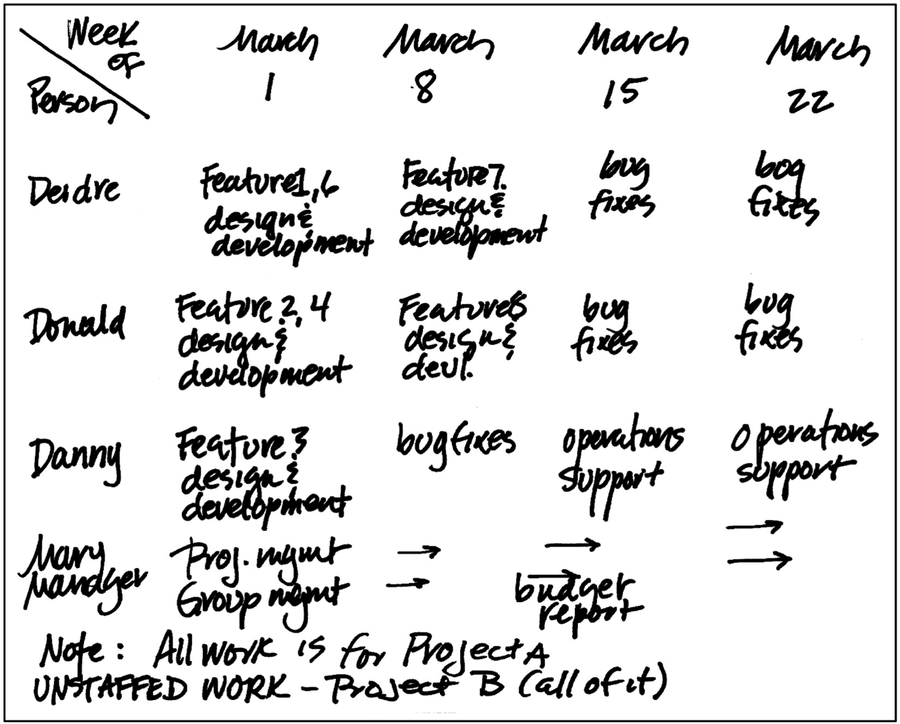Technique: Project Portfolio Planning Tips
You can’t commit to any new work without knowing about all the work in your department. We find that without formal project portfolio planning at the department level, people prioritize their own work. Sometimes we find people are working on projects their managers don’t know about. If you know what people are working on, and even more important, what’s not staffed, you’ll know whether you need more people. And, if priorities change, you’ll be able to see the effect of those changes on your group quickly.
We use a project portfolio plan that covers the next three to four weeks in detail so that we can see at a glance what people are doing, what’s unstaffed, and if priorities need to change, the effect of those priorities. We plan further out than one month but not in much detail. An example of a four-week plan that shows the work going on in one group is shown in Figure 22, Example four-week plan.

Figure 22. Example four-week plan
Guidelines
-
When you gather the universe of work, remember to gather all the work:
-
Management work
-
Project work (work toward a specific project with an end date)
-
Periodic work (such as monthly reports or yearly budgets)
-
In-process ad hoc work (work you are doing as the result of crises or other surprises)
-
Ongoing work (support for the operation of an organization or department)
-
-
Break down the pieces of work into small chunks (a week of work or less)
-
Name the work specifically. “Coding”, by itself, is too high-level a description. “Coding for the XYZ feature for the ABC project” is an appropriate description.
-
Make sure people are working on only one project at time and two at the most. The more people switch between projects, the less time they have available to work.Slack: Getting Past Burnout, Busywork, and the Myth of Total Efficiency [DeM01]The Secrets of Consulting [Wei85]
People can work on multiple tasks in the same project, but the more tasks they’re supposed to do “simultaneously,” the less they will complete.Joel on Software: And on Diverse and Occasionally Related Matters That Will Prove of Interest to Software Developers, Designers, and Managers, and to Those Who, Whether by Good Fortune or Ill Luck, Work with Them in Some Capacity [Spo04]
-
Compare the project portfolio against your priorities to see that you’re staffing the most important work. Use your mission, your job description, the department’s mission, and anything that defines what you’re responsible for delivering in your group to define priorities. For example, if your boss says you’re responsible for reducing costs, use that responsibility to define how you prioritize the work.
-
Every week, add another week to the end of the schedule (and drop the one you’ve finished). This is the rolling-wave part.
-
It’s impossible to plan the work in detail months in advance. Plan to replan the work every month or two, and add detail only to the near-term work.
-
Use a big visible chart to do the planning and show the results of planning and replanning. Use flip charts, whiteboards, sticky notes, dots, index cards, and markers. Low-tech tools help people become engaged in planning and communicate that the plan is not immutable and unchanging. Software planning tools don’t support rolling-wave plans and don’t create the opportunity for people to think about the work as a team.
